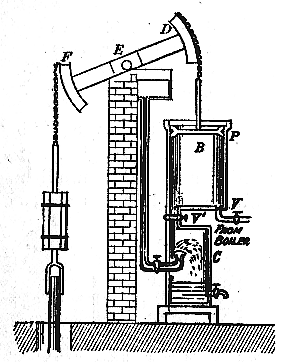Watt steam engine
|
|
The Watt steam engine was the next great step in the development of the steam engine after the Newcomen engine. Offering a dramatic increase in fuel efficiency for what was a minor design change, the new design was soon retrofitted to almost all existing Newcomen engines and then went on to be used in place of most natural power sources such as wind and water. Watt's design became synonymous with steam engines, due in no small part to his partner, Matthew Boulton.
Newcomen's design was both powerful and useful; the first example from 1711 was able to replace a team of 500 horses that had powered a wheel to pump out a mine. In over fifty years few detail changes had been made to the basic design, seventy-five of which could now be found at mines all over England.
However effective the system was, it was also expensive to run. It worked by creating a vacuum in a cylinder by condensing steam inside it. This process was normally so slow that the engine was not very effective, so to improve the condensation a small spray of water was introduced when the cylinder was filled with stream. Unfortunately, the water also cooled the cylinder walls, so when the next charge of the stream was introduced it spent some time simply warming the cylinder back up to boiling temperatures, condensing while this occured.
Watt's idea was to separate the condensation system from the cylinder, moving the cooling water in a second cylinder, C, attached to the main one through a valve V'. When the piston had reached the top of the cylinder, the valve V was closed and V' was opened. Then the steam rushed from the cylinder into the condenser, which was kept cold and under less than atmospheric pressure. At first, these valves V and V' had to be operated by hand, but later, it is said, a boy named Potter, whose job it was to turn these valves, connected the valve handles by cords to the beam ED in such a way that the machine became automatic.
A Scottish instrument maker, James Watt had met Bolton and became a member of the Lunar Society. He had told Bolton about his ideas on improving the engine, and Bolton, an avid entrepreneur, agreed to fund the development of a test engine. This proved frustrating and Watt repeatedly almost gave up on the project, only to be convinced to continue by the ever-cheery Boulton.
The improvement due to this change was dramatic: Watt's design used about 75% less fuel than a similar Newcomen engine. Since the changes were fairly limited, Watt and Boulton licensed the idea to existing Newcomen engine owners, taking a share of the cost of fuel they saved.
Watt was unwilling to rest on his laurels and continued to improve his designs throughout his life. He first turned his attention to providing rotary power from his engines, introducing a sun and planet gear system, and later adopting the more familiar crankshaft seen on most engines today. This allowed the steam engine to be used to replace water wheels, thereby freeing the British industry from geographical constraints and becoming one of the main drivers in the industrial revolution.
In order to improve reliability, he also introduced the centrifugal govenor, automatically controlling steam flow to the engine and keeping it at a steady speed. He also introduced the manometer to measure steam pressure within the engines.
Watt also continued to work on more advanced versions of the basic engine, introducing the double-acting design which used the steam twice per stroke.
The oldest working Watt engine in the world is the Smethwick Engine, at Millennium Point in Birmingham (formerly at Birmingham Museum of Science & Industry).

